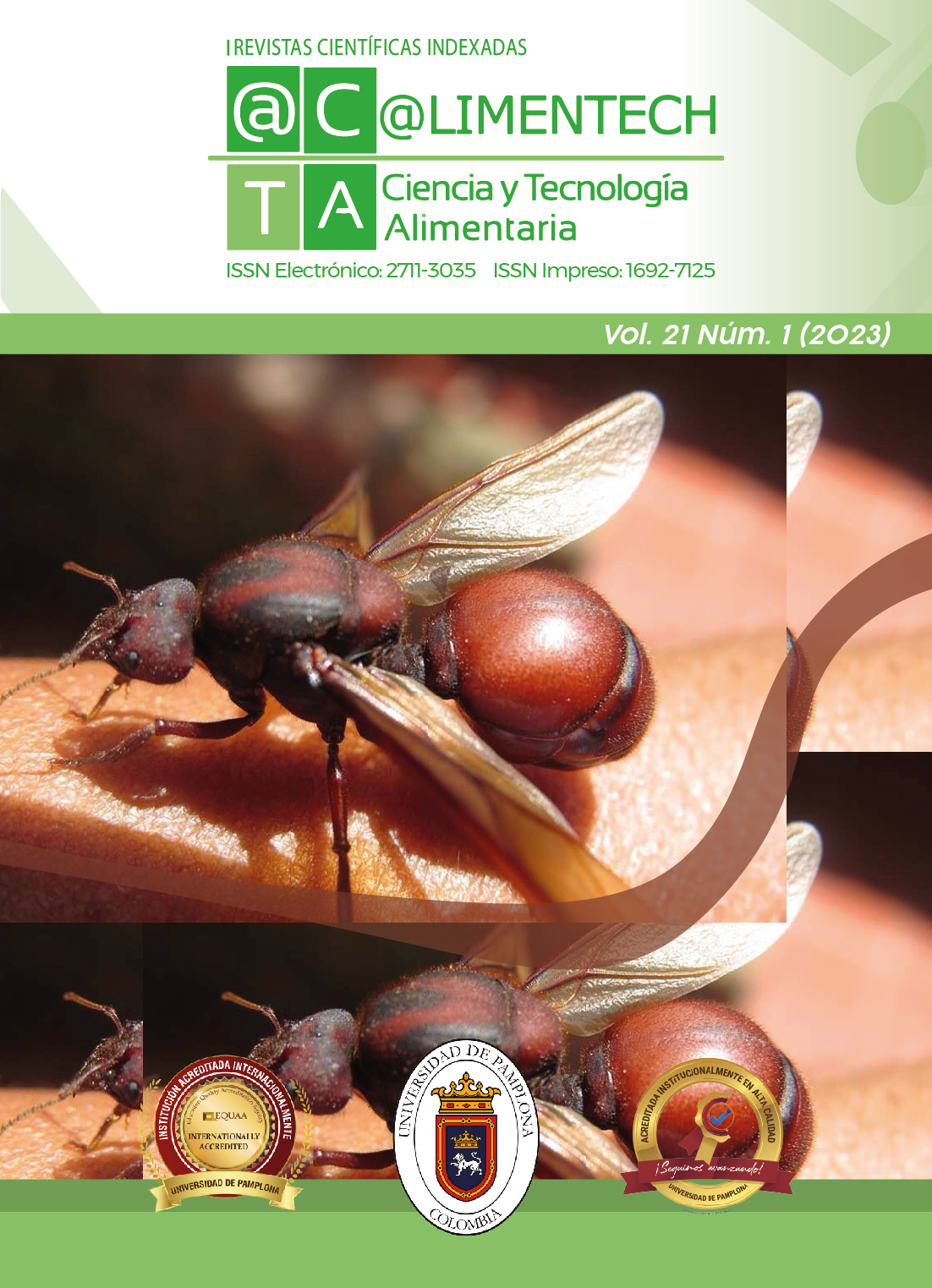Evaluation of the technological effect of egg albumin powder as a stabilizer in a cream ice cream
DOI:
https://doi.org/10.24054/limentech.v21i1.2333Keywords:
Egg albumen, ice cream, texture, stabilityAbstract
Egg products have been recognized for their use in food as a study matrix and with the intention of improving the physicochemical and sensory characteristics, such as melt resistance and structural stability, of cream-based ice creams. In this study, the incorporation of powdered albumin as a stabilizer in cream-based ice cream was evaluated due to its technological and nutritional properties. Initially, the physicochemical evaluation of egg albumin and the preparation of the ice cream (premix and mix) with different concentrations of albumin were conducted, using concentrations of 50:50, 70:30, 80:20, and 100% chemical stabilizer. Each physicochemical test for the albumin was performed in triplicate, evaluating particle size, color, gelation, and water absorption index. Similarly, tests were conducted on the cream-based ice cream, such as viscosity, melting, overrun, and free fat content. A sensory analysis was carried out among the four formulations of cream-based ice cream to observe their level of acceptability, and it was analyzed using Friedman's non-parametric test to identify significant differences between the four formulations. The best performance was obtained with the 50:50 substitution, which had an 11.47% loss percentage during the ice cream processing, attributed to its water absorption capacity, a functional property of proteins. The sample that received the highest acceptance from panelists in terms of color, taste, smell, and texture was coded 987, representing the 80:20 formulation of egg albumin and xanthan gum. Finally, costs were calculated, yielding a value of $3,488 COP for an 85-gram presentation with a 100% substitution.
Downloads
References
Alleoni, A. (2006). Albumen protein and functional properties of gelation and foaming [en línea]. Scientia Agrícola, 63(3), 291-298. Consultado 10 set. 2021. Disponible en http://www.scielo.br/pdf/sa/v63n3/29835.pdf
Anderson, R., Conway, H. F., Pheiser, V. F., & Griffin, E. L. (1969). Gelatinisation of corn grits by roll and extrusion cooking. Cereal Science Today, 14, 4-12.
Arzeni, C., Pérez, O., & Pilosof, A. (2012). Functionality of egg white proteins as affected by high intensity ultrasound. Food Hydrocolloids, 29(2), 308-316. Elsevier. Doi: https://doi.org/10.1016/j.foodhyd.2012.03.009
Bolívar Meléndez, W. Y., & Díaz Rodríguez, G. (2020). Caracterización de la compra del huevo y el consumo de ovoproductos en la ciudad de Manizales-Caldas.
Callejas Garzón, A. M., & Ramírez Gamboa, J. N. (2018). Aprovechamiento de huevo deshidratado en la elaboración de un producto cárnico emulsionado.
Castel, M. V. (2010). Estudio de las propiedades funcionales, tecnológicas y fisiológicas de las proteínas de amaranto (Doctoral dissertation).
Cerezal Mezquita, P., Urtuvia Gatica, V., Ramírez Quintanilla, V., & Arcos Zavala, R. (2011). Desarrollo de producto sobre la base de harinas de cereales y leguminosa para niños celíacos entre 6 y 24 meses; II: Propiedades de las mezclas. Nutrición Hospitalaria, 26(1), 161-169.
Contorni, C. (s.f.). Alimara: alimentación especializada. [En línea]. Consultado: [28, septiembre 2021]. Disponible en: http://www.alimaraingredients.com/index.php?pg=emulsionantes&mn=1
David, L. R. P., Valencia, J. U. S., & Molina, D. A. R. (2012). Selección y evaluación de un estabilizante integrado de gomas sobre las propiedades de calidad en mezclas para helado duro. Vitae, 19(2), 166-177.
@LIMENTECH Ciencia y Tecnología Alimentaria. ISSN Impreso 1692-7125/ ISSN Electrónico 2711-3035. Volumen 21 No. 1, p. 48-68, año 2023. Facultad de Ingenierías y Arquitectura, Universidad de Pamplona.
Dina, J. (2001). Formación y estabilidad de espumas de proteínas de soja: efectos de la desnaturalización térmica y de la interacción con polisacáridos. Biblioteca Digital FCEN-UBA. Obtenido de https://bibliotecadigital.exactas.uba.ar/download/tesis/tesis_n3333_Carp.pdf
Elizalde, B. E. (1987). Propiedades funcionales y físico-químicas de las proteínas en relación a su comportamiento en las emulsiones alimenticias (Doctoral dissertation, Universidad de Buenos Aires. Facultad de Ciencias Exactas y Naturales).
Fenavi. (2018). El sector avícola en Colombia creció 4.5% en 2018. Recuperado: https://fenavi.org/comunicados-de-prensa/el-sector-avicola-crecio-45-en-2018/
Grace, M. R. (1977). Elaboración de la yuca. Organización de las Naciones Unidas para la Agricultura y la Alimentación (FAO), Roma. 116 pp.
Goff, H. D. (2011). Ice cream and desserts. En J. W. Fuquay, P. F. Fox, & P. L. H. McSweeney (Eds.), Encyclopedia of Dairy Sciences, Academic Press: San Diego [en línea], 2, pp. 899-904.
ISI. (1999). Determination of starch size distribution by screening. ISI 32-1e. In: Laboratory methods. Science Park, Aarhus, Dinamarca, International Starch Institute (ISI). Disponible en http://www.starch.dk/isi/methods/index.htm
Kobashikawa Shimabukuro, K. (2017). Propiedades tecno-funcionales de los ovoproductos destinados para exportación.
Lewis, M. (1993). Propiedades Físicas de Los Alimentos y de Los Sistemas de Procesado. Editorial Acribia S.A.
Lanzerstorfer, C. (2020). Densidad aparente de polvos alimenticios comprimibles en condiciones de almacenamiento. Diario de Ingeniería de Alimentos, 276, 109897.
Meléndez-Martínez, A. J., Vicario, I. M., & Francisco, H. (2004). Importancia nutricional de los pigmentos carotenoides. Archivos Latinoamericanos de Nutrición, 54(2), 149-155.
@LIMENTECH Ciencia y Tecnología Alimentaria. ISSN Impreso 1692-7125/ ISSN Electrónico 2711-3035. Volumen 21 No. 1, p. 48-68, año 2023. Facultad de Ingenierías y Arquitectura, Universidad de Pamplona.
Posada, D. L. R., Sepulveda, J. U., & Restrepo, D. A. (2012). Selección y evaluación de un estabilizante integrado de gomas sobre las propiedades de calidad en mezclas para helado duro. Vitae, 19(2), 166-177.
Rua, V. (2019). Evaluación de la aceptación y preferencia sensorial de dos variedades de helados comerciales sabor a chocolate. Universidad de Santiago de Cali, 33.
Sobral, P. A., & Wagner, J. R. (2010). Capacidad emulsionante de sueros de soja. Innotec, 5, 63-65.
Sofjan, R. P., & Hartel, R. W. (2004). Effects of overrun on structural and physical characteristics of ice cream. Int. Dairy J. [en línea], 14(3), 255-262.
Su, Y., Dong, Y., Niu, F., Wang, C., Liu, Y., & Yang, Y. (2015). Study on the gel properties and secondary structure of soybean protein isolate/egg white composite gels. European Food Research and Technology, 240(2), 367–378.
Tubón Usca, I. R. (2013). Formulación, Elaboración y Evaluación de Bioenvase para Caramelos a Base de Almidón de Yuca, Sacarosa y Gelatina (Bachelor's thesis, Escuela Superior Politécnica de Chimborazo).
Downloads
Published
How to Cite
Issue
Section
License
Copyright (c) 2023 @limentech, Ciencia y Tecnología Alimentaria

This work is licensed under a Creative Commons Attribution-NonCommercial 4.0 International License.








